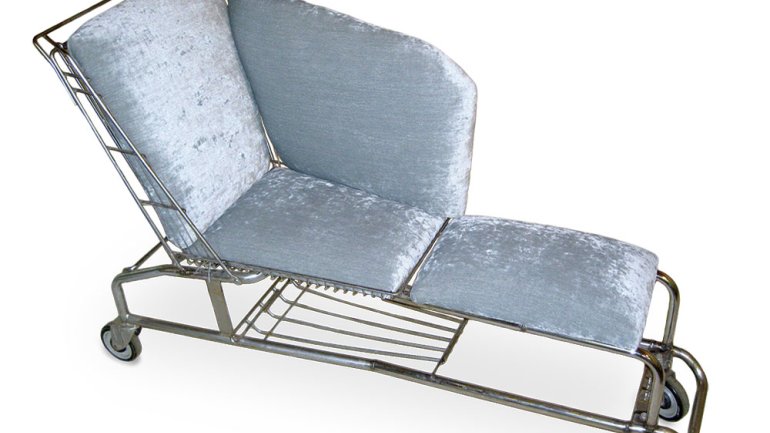Necessity, Mother of Cool Furniture
Necessity, Mother of Cool Furniture
Doug Meyer made his design bones with wheelchair loveseats and shopping-cart chaise lounges that dare the adventurous to go careening down the cereal aisle. But his work also includes a sleek, neo-deco Paperclip Console and an elegant, post-industrial Capsule Coffee Table.
"There are facets of my creativity I always have to fulfill," says Meyer, 36, from his home outside Cleveland. "Some of my work is damn serious, and some of it's just straight-up goofy. It's all what you see in it."
Others see plenty. His work has been picked up by Corey Daniels Gallery in Wells, Maine, and Liza Sherman Antiques in New York, by a high-end home furnishing store in Boston, and for merchandising displays for well-known retailers, such as Tommy Hilfiger and J. Crew.
Not bad for a kid from Akron, Ohio, who learned his craft the old-fashioned way: on the job.
The once-mighty capital of rubber had long been struggling by the time Meyer graduated from high school. In his art classes, he "fell in love with sculpture," but he didn't have the money for college. So after working in a straw factory for $6.15 an hour, he and a few friends hit the road and headed for California.
They made it to Salt Lake City before the cash ran out. Meyer stayed, found his way into the Job Corps, a trade-school program for low-income youth, and learned to weld. Armed with new skills, he headed back to Ohio and found industrial work. Off the job, he began scavenging abandoned bikes and "anything that was metal," making sculpture and furniture.
He eventually landed a six-month gig working for an artist-craftsman friend, Mike Moritz, who needed an ace welder for his architectural fabrication business in Cleveland. Given the variety of work and Moritz's meticulous methods, Meyer says he learned more about his craft in that short stretch than anywhere else.
His next break came with furniture maker Jason Wein, another mentor, who let him contribute design ideas and taught him the all-important business side. Meyer worked for Wein for about four years before striking out on his own about 18 months ago. (Wein sells Meyer's work through his company, Cleveland Art, specializing in recycled industrial design.)
As Rustbelt Rebirth, Meyer now works near his home in a converted barn. (A huge mural of underwater life bears witness to the barn's unlikely previous life as a scuba shop.) Recently he marked a couple of record months. Though he has two employees, he remains deeply involved in fabrication. And he still uses all post-consumer materials, though he's moved from curbside "pick-up" to buying materials wholesale.
His recycling ethos extends to his "segmenting" technique, joining smaller pieces of, say, sheet metal to form a bigger piece rather than cutting a single sheet to fit and tossing the scrap. Meyer welcomes the serendipity: He doesn't do any custom paint work, for example; he just ensures he has enough colored sheet metal on hand. "The materials decide the color - I've just given it a little guidance," he says. "I have no sense of color; thank God the material does."
He also welcomes the patina old metal has. "I'm working with material that might have been used for maybe 40, 50 years, and it bears the distress of what it's gone through. That's nothing you can make happen - it's something you have to let happen."
Despite his early success, Meyer acknowledges that his chic, witty work will probably never sell big with, say, mid-range furniture retailers. Does he ever worry that it could be left behind in the next design vogue?
"From an artistic point of view, my work is constantly changing," Meyer says, and that questing spirit may just be his best insurance against the changing tides of fashion. "Maybe what I'm doing now chimes with what's selling now; maybe it's just that it's well made and creative." And that never goes out of style. ~Judy Arginteanu
Judy Arginteanu is American Craft's copy editor.




